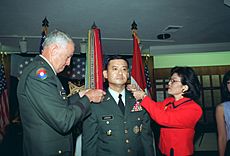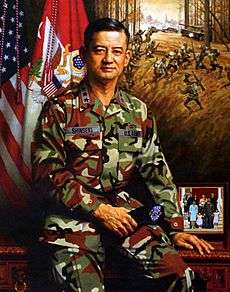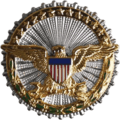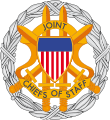Eric Shinseki facts for kids
Quick facts for kids
Eric Shinseki
|
|
|---|---|
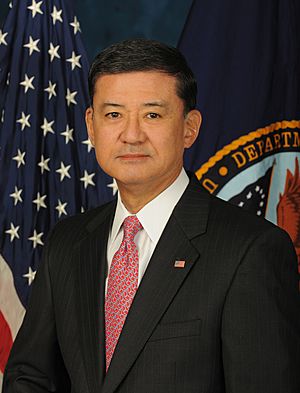
Official portrait, 2009
|
|
| 7th United States Secretary of Veterans Affairs | |
| In office 21 January 2009 – 30 May 2014 |
|
| President | Barack Obama |
| Deputy | W. Scott Gould Sloan D. Gibson |
| Preceded by | James Peake |
| Succeeded by | Bob McDonald |
| 34th Chief of Staff of the United States Army | |
| In office 21 June 1999 – 11 June 2003 |
|
| President | Bill Clinton George W. Bush |
| Preceded by | Dennis Reimer |
| Succeeded by | Peter Schoomaker |
| 28th Vice Chief of Staff of the United States Army | |
| In office 24 November 1998 – June 21, 1999 |
|
| President | Bill Clinton |
| Preceded by | William W. Crouch |
| Succeeded by | Jack Keane |
| Personal details | |
| Born | 28 November 1942 Lihue, Hawaii, U.S. |
| Spouse | Patricia Shinseki |
| Children | 2 |
| Education | United States Military Academy (BS) Duke University (MA) |
| Military service | |
| Allegiance | United States |
| Branch/service | United States Army |
| Years of service | 1965–2003 |
| Rank | General |
| Commands | Chief of Staff of the United States Army Vice Chief of Staff of the United States Army Seventh United States Army Allied Land Forces Central Europe NATO Stabilization Force in Bosnia and Herzegovina 1st Cavalry Division 2nd Brigade, 3rd Infantry Division 3rd Squadron, 7th Cavalry Regiment, 3rd Infantry Division 3rd Squadron, 5th Cavalry Regiment, 9th Infantry Division |
| Battles/wars | Vietnam War Bosnian War |
| Awards | Defense Distinguished Service Medal (2) Army Distinguished Service Medal (2) Navy Distinguished Service Medal Air Force Distinguished Service Medal Coast Guard Distinguished Service Medal Legion of Merit (2) Bronze Star Medal (3) Purple Heart (2) |
Eric Ken Shinseki, born on November 28, 1942, is a retired U.S. Army general. He held important roles in the government. He was the seventh Secretary of Veterans Affairs from 2009 to 2014. Before that, he was the 34th Chief of Staff of the Army from 1999 to 2003.
Shinseki served two times in the Vietnam War. He earned three Bronze Star Medals for his bravery. He also received two Purple Hearts for injuries during combat. He was the first Asian American to become a four-star general. He was also the first Asian American to serve as Secretary of Veterans Affairs.
Contents
Early Life and Education
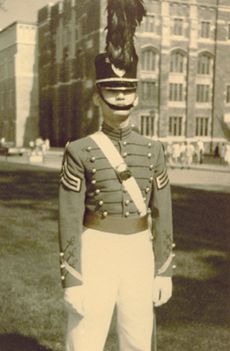
Eric Shinseki was born in Lihue, Kauaʻi, which was then the Territory of Hawaii. His family was of Japanese ancestry. His grandparents moved from Hiroshima to Hawaii in 1901.
He grew up in a sugarcane farming area on Kauaʻi. He graduated from Kauaʻi High and Intermediate School in 1960. While in high school, he was active in the Boy Scouts. He also served as his class president.
Shinseki learned that three of his uncles fought in the 442nd Infantry Regiment. This unit was made of Japanese Americans. It became one of the most honored fighting units in U.S. history. Inspired by his uncles, he went to the United States Military Academy. He graduated in 1965 with a science degree. He became a second lieutenant.
In 1974, he earned a master's degree in English Literature from Duke University. He also studied at other military colleges. These included the United States Army Command and General Staff College. He also attended the National War College.
Military Service and Leadership
Shinseki served in many different roles in the U.S. and overseas. He had two combat tours in the Republic of Vietnam. He was an artillery forward observer. He also commanded a troop in the 5th Cavalry Regiment. This was during the Vietnam War.
During one tour, he stepped on a land mine. This caused a serious injury to his foot. He spent almost a year recovering. He returned to active duty in 1971.
Shinseki also taught at the U.S. Military Academy. He served in Europe for over ten years. He commanded the 3rd Squadron, 7th Cavalry. He also commanded the 2nd Brigade, 3rd Infantry Division. He was also Assistant Chief of Staff for Operations.
From 1994 to 1995, Shinseki led the 1st Cavalry Division. In 1996, he became a lieutenant general. In 1997, he was promoted to general. He then commanded the Seventh United States Army. He also led the NATO Stabilization Force in Bosnia and Herzegovina.
Shinseki became the Army's 28th Vice Chief of Staff in 1998. He then became the 34th Chief of Staff in 1999. He was the last Vietnam War veteran to hold this position. Shinseki retired on June 11, 2003. He had served in the Army for 38 years.
Shinseki was the highest-ranked Asian American military officer in U.S. history as of 2009. He was also the highest-ranked Japanese American in the U.S. Armed Forces as of 2004.
Army Chief of Staff Decisions
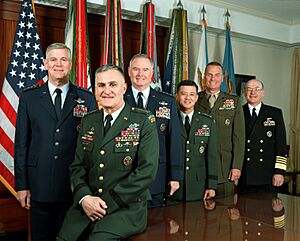
As Army Chief of Staff, Shinseki started new plans. He wanted to make the army more mobile. He created Stryker Interim-Force Brigade Combat Teams. He also had a long-term plan called "Objective Force." This included a program called Future Combat Systems.
Another change Shinseki made was for all army personnel to wear the black beret. Before this, only the U.S. Army Rangers wore the black beret. After the change, the Rangers started wearing the tan beret.
Shinseki had a public disagreement with Secretary of Defense Donald Rumsfeld. This was during the planning for the war in Iraq. Shinseki believed that "several hundred thousand soldiers" would be needed for postwar Iraq. This was a much higher number than what Secretary Rumsfeld suggested. Rumsfeld and his deputy, Paul Wolfowitz, disagreed strongly with Shinseki.
Some people believed Shinseki was forced to retire early because of his comments. However, his retirement was announced almost a year before these comments. Later, when problems arose in Iraq, many people said Shinseki had been right about needing more troops.
After Military Service

After retiring from the military, Shinseki joined the boards of several companies. These included Honeywell International and Ducommun, which are military contractors. He also served on advisory boards for Harvard University and the U.S. Comptroller General. He is a member of the Council on Foreign Relations.
Secretary of Veterans Affairs (2009–2014)
On December 7, 2008, President-elect Barack Obama announced his choice. He would nominate Shinseki to be the Secretary of Veterans Affairs. The United States Senate approved Shinseki unanimously on January 20, 2009. He was sworn in the next day.
Challenges in the Department
In May 2014, issues came to light within the Veterans Health Administration. This is a part of the Department of Veterans Affairs. There were concerns about veterans not getting timely care. There were also reports of false records. These records seemed to hide long wait times at some veterans hospitals.
On May 30, 2014, President Obama announced that he accepted Shinseki's resignation. Shinseki stated he could not explain the lack of honesty among some leaders. He said it was "irresponsible, it is indefensible, and unacceptable to me." He took responsibility for the problems. His resignation meant that for the first time since 2000, there was no Asian American in the Cabinet of the United States.
Family Life
Shinseki is married to his high school sweetheart, Patricia. They have two children, Lori and Ken. They also have seven grandchildren.
Images for kids
See also
 In Spanish: Eric Shinseki para niños
In Spanish: Eric Shinseki para niños


